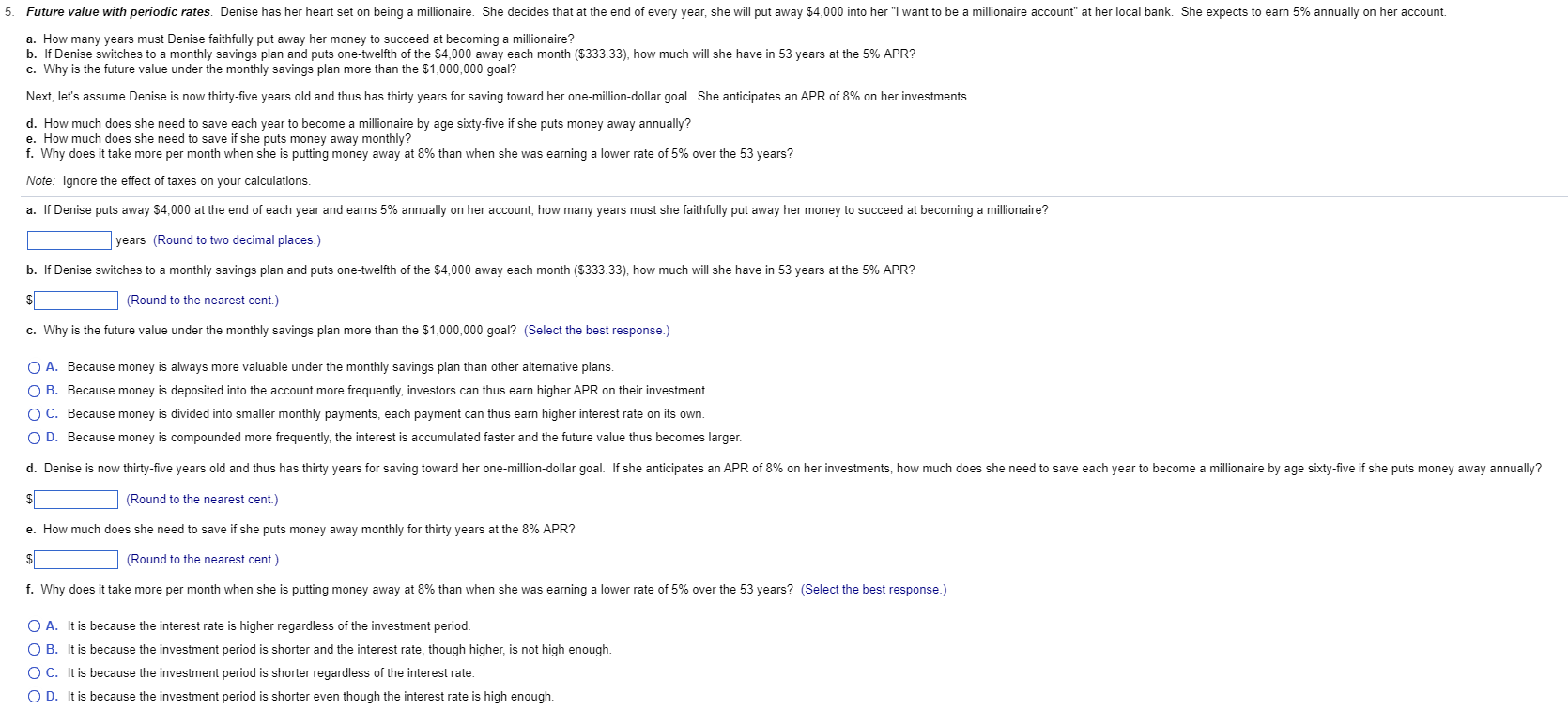Answered step by step
Verified Expert Solution
Question
1 Approved Answer
a. How many years must Denise faithfully put away her money to succeed at becoming a millionaire? b. If Denise switches to a monthly savings
 a. How many years must Denise faithfully put away her money to succeed at becoming a millionaire? b. If Denise switches to a monthly savings plan and puts one-twelfth of the $4,000 away each month ( $333.33 ), how much will she have in 53 years at the 5% APR? c. Why is the future value under the monthly savings plan more than the $1,000,000 goal? Next, let's assume Denise is now thirty-five years old and thus has thirty years for saving toward her one-million-dollar goal. She anticipates an APR of 8% on her investments. d. How much does she need to save each year to become a millionaire by age sixty-five if she puts money away annually? e. How much does she need to save if she puts money away monthly? f. Why does it take more per month when she is putting money away at 8% than when she was earning a lower rate of 5% over the 53 years? Note: Ignore the effect of taxes on your calculations. a. If Denise puts away $4,000 at the end of each year and earns 5% annually on her account, how many years must she faithfully put away her money to succeed at becoming a millionaire? years (Round to two decimal places.) b. If Denise switches to a monthly savings plan and puts one-twelfth of the $4,000 away each month ( $333.33 ), how much will she have in 53 years at the 5% APR? 9 (Round to the nearest cent.) c. Why is the future value under the monthly savings plan more than the $1,000,000 goal? (Select the best response.) A. Because money is always more valuable under the monthly savings plan than other alternative plans. B. Because money is deposited into the account more frequently, investors can thus earn higher APR on their investment. C. Because money is divided into smaller monthly payments, each payment can thus earn higher interest rate on its own. D. Because money is compounded more frequently, the interest is accumulated faster and the future value thus becomes larger. (Round to the nearest cent.) e. How much does she need to save if she puts money away monthly for thirty years at the 8% APR? (Round to the nearest cent.) f. Why does it take more per month when she is putting money away at 8% than when she was earning a lower rate of 5% over the 53 years? (Select the best response.) A. It is because the interest rate is higher regardless of the investment period. B. It is because the investment period is shorter and the interest rate, though higher, is not high enough. C. It is because the investment period is shorter regardless of the interest rate. D. It is because the investment period is shorter even though the interest rate is high enough
a. How many years must Denise faithfully put away her money to succeed at becoming a millionaire? b. If Denise switches to a monthly savings plan and puts one-twelfth of the $4,000 away each month ( $333.33 ), how much will she have in 53 years at the 5% APR? c. Why is the future value under the monthly savings plan more than the $1,000,000 goal? Next, let's assume Denise is now thirty-five years old and thus has thirty years for saving toward her one-million-dollar goal. She anticipates an APR of 8% on her investments. d. How much does she need to save each year to become a millionaire by age sixty-five if she puts money away annually? e. How much does she need to save if she puts money away monthly? f. Why does it take more per month when she is putting money away at 8% than when she was earning a lower rate of 5% over the 53 years? Note: Ignore the effect of taxes on your calculations. a. If Denise puts away $4,000 at the end of each year and earns 5% annually on her account, how many years must she faithfully put away her money to succeed at becoming a millionaire? years (Round to two decimal places.) b. If Denise switches to a monthly savings plan and puts one-twelfth of the $4,000 away each month ( $333.33 ), how much will she have in 53 years at the 5% APR? 9 (Round to the nearest cent.) c. Why is the future value under the monthly savings plan more than the $1,000,000 goal? (Select the best response.) A. Because money is always more valuable under the monthly savings plan than other alternative plans. B. Because money is deposited into the account more frequently, investors can thus earn higher APR on their investment. C. Because money is divided into smaller monthly payments, each payment can thus earn higher interest rate on its own. D. Because money is compounded more frequently, the interest is accumulated faster and the future value thus becomes larger. (Round to the nearest cent.) e. How much does she need to save if she puts money away monthly for thirty years at the 8% APR? (Round to the nearest cent.) f. Why does it take more per month when she is putting money away at 8% than when she was earning a lower rate of 5% over the 53 years? (Select the best response.) A. It is because the interest rate is higher regardless of the investment period. B. It is because the investment period is shorter and the interest rate, though higher, is not high enough. C. It is because the investment period is shorter regardless of the interest rate. D. It is because the investment period is shorter even though the interest rate is high enough Step by Step Solution
There are 3 Steps involved in it
Step: 1

Get Instant Access to Expert-Tailored Solutions
See step-by-step solutions with expert insights and AI powered tools for academic success
Step: 2

Step: 3

Ace Your Homework with AI
Get the answers you need in no time with our AI-driven, step-by-step assistance
Get Started


